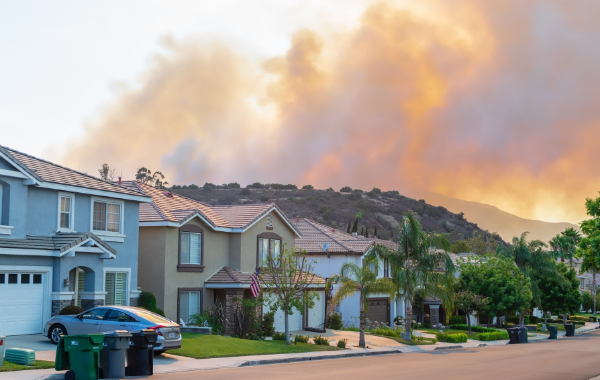
Right now, there are scores of large fires burning in California, Oregon, and Washington.In a recent CBS News article called, “Wildfires and weather extremes: It’s not coincidence, it’s climate change,” California has seen a record 3.3 million acres burn so far this year — roughly 5 times the normal for an entire season (typically July through November), and 10 times the normal year to date.What’s crazy is that it’s estimated that California itself could see a 77% increase in land destroyed by wildfires by 2050.
Climate change has been a key factor in increasing the risk and extent of wildfires in the U.S.According to the Center for Climate and Energy Solutions website, once a fire starts – more than 80 percent of U.S.wildfires are caused by people – warmer temperatures and drier conditions can help fires spread and make them harder to put out.
Unfortunately, changes in climate and risk factors are expected to continue to increase the area affected by wildfires.It will be as important as ever to be proactive, prepared, and protected from wildfires.Be Proactive: Prevent or reduce damages to your property.
Create a defensible space of 50-100 feet around your home (clearing combustible vegetation)Clear all vegetation debris (leaves, branches, dead vegetation) from the roof, gutters, and any open deckingUp-Limb all your trees in this defensible space – (remove limbs up to 15 ft.)Plant non-combustible plants and vegetationHave your local fire department inspect the property and provide any recommendations to reduce your fire hazard at your home.Be Prepared: Know when and how to safely evacuate should you need to.Sign up for your community’s emergency alert system.The Emergency Alert System (EAS) and National Oceanic and Atmospheric Administration (NOAA) also provide alerts.Pack an emergency bag with things like non-perishable food, water, medication, and N95 masks for everyone in your family.Store important documents in a fireproof safe.Determine the safest evacuation routes ahead of time, and make sure your family knows them.If you receive an evacuation order, leave as soon as possible.Wear your N95 masks during evacuation and keep track of air quality alerts.
Only remove masks when you’re in well-filters or clean air again.Steer clear of charred trees and other debris.They could contain embers that can catch fire.If you need to walk outside, make sure to cover your head and any exposed skin from flying embers.It may be tempting to return home once the fires abate, but don’t do so until instructed by authorities.Be Protected: Have the insurance coverage you need.Review your homeowner’s or renter’s policy with your agent to make sure your limits are adequate and your coverage is up to date.If you are forced to evacuate, your insurance policy may provide coverage for your living expenses. The basic HO-3 policy provides loss of use coverage for up to 14 days when a civil authority prohibits you from using your home. This covers your expense to stay at a hotel and the extra cost of eating out for your meals.If your home is actually burned in the wildfire and is not fit to live in, most standard homeowner’s policies provide coverage for any necessary increase in living expenses incurred by you so that your household can maintain its normal standard of living.Should your home and belongings be lost to fire, having a household inventory can speed up your claim settlement. It’s easy to do – check out Central’s how-to video.Also, here are some great online preparation resources for you to know about and share with your family.
The Wildfires page at Ready.gov offers preparation and safety tips for before, during, and after a wildfire.The Wildfires: insurance and recovery resources page on the Insurance Information Institute website.The American Red Cross’ How to Prevent Wildfires page and the 2020 Wildfires Relief Information page.Use these three P’s from now on.Be smart when dealing with fire in any and every circumstance, because the safety of you, your loved ones, your home, and your community is at stake.The information above is of a general nature and your policy and coverages provided may differ from the examples provided.
Please read your policy in its entirety to determine your actual coverage available.Share this:FacebookTwitterLinkedInMoreEmailPrintLike this:
Publisher: Central Insurance Companies








